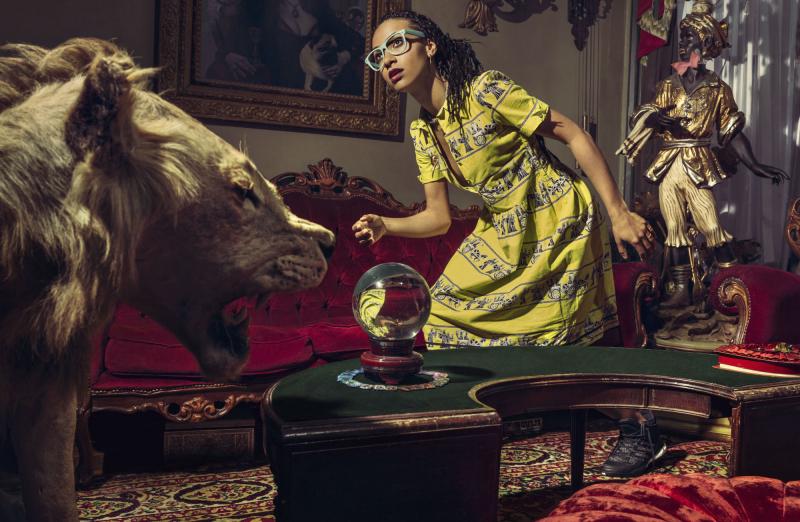Esperanza Spalding's Emily D+Evolution, O2 Shepherd's Bush | reviews, news & interviews
Esperanza Spalding's Emily D+Evolution, O2 Shepherd's Bush
Esperanza Spalding's Emily D+Evolution, O2 Shepherd's Bush
Acclaimed singer and bassist strikes out on ambitious multi-form experiment

Until last night, critics had a clear view of Esperanza Spalding as the virtuosic jazz bassist and singer, whose prodigious composing, performing and bandleading made her one of a small and precious group capable of re-making serious and popular jazz. In a rare moment of triumphalism, jazz critics love nothing more than recalling the fury of Justin Bieber fans, whom Spalding beat to the Best New Artist Grammy in 2011. Best get that story out the way before we go any further.
Last night, however, she redefined her career with Emily’s D+Evolution, an extraordinary, zany multi-form experimental project comprising theatre, poetry and music, based on her own theories of free-form, decentralised (“devolution”) education. The idea came to her, apparently, in the middle of the night, during a full moon. Emily, her middle name, is supposed to represent her inner child, while the concepts explored in the show celebrate the intuition and instinct with which a child learns. It may surprise fans of her over-achieving career that she wasn’t an automatic A-grade student at school, and her recollections of this motivate much of her enquiry. An album of the project is already recorded and will be released, unusually, after her extensive global tour is complete.
Emily D+Evolution has strong echoes of Seventies bands such as Weather Report
Musically, it’s very different from her existing work. It’s not – shockingly for some – mainly jazz, though there are extended, improvised dialogues between Spalding, guitarist Matthew Stevens and drummer Justin Tyson that would make John McLaughlin proud. The centre of proceedings is a rock power trio, consisting of these three, with Corey King and Emily Elbert providing supporting vocals, and electronica and acoustic guitar, respectively. Spalding herself was on superb form, switching effortlessly between four-string Fender jazz bass, to her five-string fretless, singing in her unmistakeably pure-toned, agile voice, and sometimes playing keyboards too.
Spalding has spoken at length in interviews about the theatrical elements of this project, but on the evidence of last night, the relationship between music and lyrics are the show’s most interesting feature. “Ebony and Ivy”, for example, which alludes to a recent American study of how Ivy League universities depended on slavery for their development, began with a group declamation of poetry read from mock-academic scrolls. It was very difficult to make out the lyrics in the hall, however, and the visual theatrical protest lacked the subtlety of the music or literary concept.
“Noble Nobles” sought to explore the positive features of the noble savage, though again, the music and lyrics approached the topic with much more complexity than Spalding’s floral headdress, which had a touch of pantomime about it. This was also the case, for me, with the musical excerpts of Elgar’s Pomp and Circumstance March No 1, which began “Ebony and Ivy”. Spalding's allusiveness took a lighter form elsewhere, for example, with “Hello Dolly”. To approach such big themes with a multi-faceted project that strives for satirical effect as well as more delicate forms of engagement is an ambitious task requiring further refinement to avoid cartoonish gestures. The attempt was highly invigorating.
 In embracing the character of Emily, Spalding has created an extravagant appearance (pictured right), with tight braids replacing her trademark ‘fro, and aquamarine nerd glasses to complement the educational parody of many of these songs. In style and purpose, Emily D+Evolution has strong echoes of Seventies bands classed broadly as jazz fusion, such as Weather Report, The Mahavishnu Orchestra and Miles Davis’ range of electronic outfits. The engagement with intriguing, sometimes outlandish ideas from education and philosophy helps here too. In the stridency and vividness of her (ever so slightly sloganising) declamations in “Funk the Fear” among other tracks, there was, at times, a sense that Spalding had created her Emily alter-ego as an escape from a rather over-programmed, over-scripted jazz career.
In embracing the character of Emily, Spalding has created an extravagant appearance (pictured right), with tight braids replacing her trademark ‘fro, and aquamarine nerd glasses to complement the educational parody of many of these songs. In style and purpose, Emily D+Evolution has strong echoes of Seventies bands classed broadly as jazz fusion, such as Weather Report, The Mahavishnu Orchestra and Miles Davis’ range of electronic outfits. The engagement with intriguing, sometimes outlandish ideas from education and philosophy helps here too. In the stridency and vividness of her (ever so slightly sloganising) declamations in “Funk the Fear” among other tracks, there was, at times, a sense that Spalding had created her Emily alter-ego as an escape from a rather over-programmed, over-scripted jazz career.
The openness and excitement of her experimentation (as well as the virtuosity of the playing) made the project a thrilling evening’s entertainment. Some features were perhaps striving too hard for effect. A project like this is much better to try too hard at than not hard enough, however, and lovers of experimental music will celebrate Spalding’s emergence as Emily, and look forward to the next chapter in her d+evolution.
The future of Arts Journalism
You can stop theartsdesk.com closing!
We urgently need financing to survive. Our fundraising drive has thus far raised £49,000 but we need to reach £100,000 or we will be forced to close. Please contribute here: https://gofund.me/c3f6033d
And if you can forward this information to anyone who might assist, we’d be grateful.

Subscribe to theartsdesk.com
Thank you for continuing to read our work on theartsdesk.com. For unlimited access to every article in its entirety, including our archive of more than 15,000 pieces, we're asking for £5 per month or £40 per year. We feel it's a very good deal, and hope you do too.
To take a subscription now simply click here.
And if you're looking for that extra gift for a friend or family member, why not treat them to a theartsdesk.com gift subscription?
more New music
 Music Reissues Weekly: The Peanut Butter Conspiracy - The Most Up Till Now
Definitive box-set celebration of the Sixties California hippie-pop band
Music Reissues Weekly: The Peanut Butter Conspiracy - The Most Up Till Now
Definitive box-set celebration of the Sixties California hippie-pop band
 Doja Cat's 'Vie' starts well but soon tails off
While it contains a few goodies, much of the US star's latest album lacks oomph
Doja Cat's 'Vie' starts well but soon tails off
While it contains a few goodies, much of the US star's latest album lacks oomph
 Mariah Carey is still 'Here for It All' after an eight-year break
Schmaltz aplenty but also stunning musicianship from the enduring diva
Mariah Carey is still 'Here for It All' after an eight-year break
Schmaltz aplenty but also stunning musicianship from the enduring diva
 Album: Solar Eyes - Live Freaky! Die Freaky!
Psychedelic indie dance music with a twinkle in its eye
Album: Solar Eyes - Live Freaky! Die Freaky!
Psychedelic indie dance music with a twinkle in its eye
 Album: Night Tapes - portals//polarities
Estonian-voiced, London-based electro-popsters' debut album marks them as one to watch for
Album: Night Tapes - portals//polarities
Estonian-voiced, London-based electro-popsters' debut album marks them as one to watch for
 Album: Mulatu Astatke - Mulatu Plays Mulatu
An album full of life, coinciding with a 'farewell tour'
Album: Mulatu Astatke - Mulatu Plays Mulatu
An album full of life, coinciding with a 'farewell tour'
 Music Reissues Weekly: Sly and the Family Stone - The First Family: Live At Winchester Cathedral 1967
Must-have, first-ever release of the earliest document of the legendary soul outfit
Music Reissues Weekly: Sly and the Family Stone - The First Family: Live At Winchester Cathedral 1967
Must-have, first-ever release of the earliest document of the legendary soul outfit
 Album: Robert Plant - Saving Grace
Mellow delight from former Zep lead
Album: Robert Plant - Saving Grace
Mellow delight from former Zep lead
 Brìghde Chaimbeul, Round Chapel review - enchantment in East London
Inscrutable purveyor of experimental Celtic music summons creepiness and intensity
Brìghde Chaimbeul, Round Chapel review - enchantment in East London
Inscrutable purveyor of experimental Celtic music summons creepiness and intensity
 Album: NewDad - Altar
The hard-gigging trio yearns for old Ireland – and blasts music biz exploitation
Album: NewDad - Altar
The hard-gigging trio yearns for old Ireland – and blasts music biz exploitation
 First Person: Musician ALA.NI on how thoughts of empire and reparation influenced a song
She usually sings about affairs of the heart - 'TIEF' is different, explains the star
First Person: Musician ALA.NI on how thoughts of empire and reparation influenced a song
She usually sings about affairs of the heart - 'TIEF' is different, explains the star
 Album: The Divine Comedy - Rainy Sunday Afternoon
Neil Hannon takes stock, and the result will certainly keep his existing crowd happy
Album: The Divine Comedy - Rainy Sunday Afternoon
Neil Hannon takes stock, and the result will certainly keep his existing crowd happy

Add comment